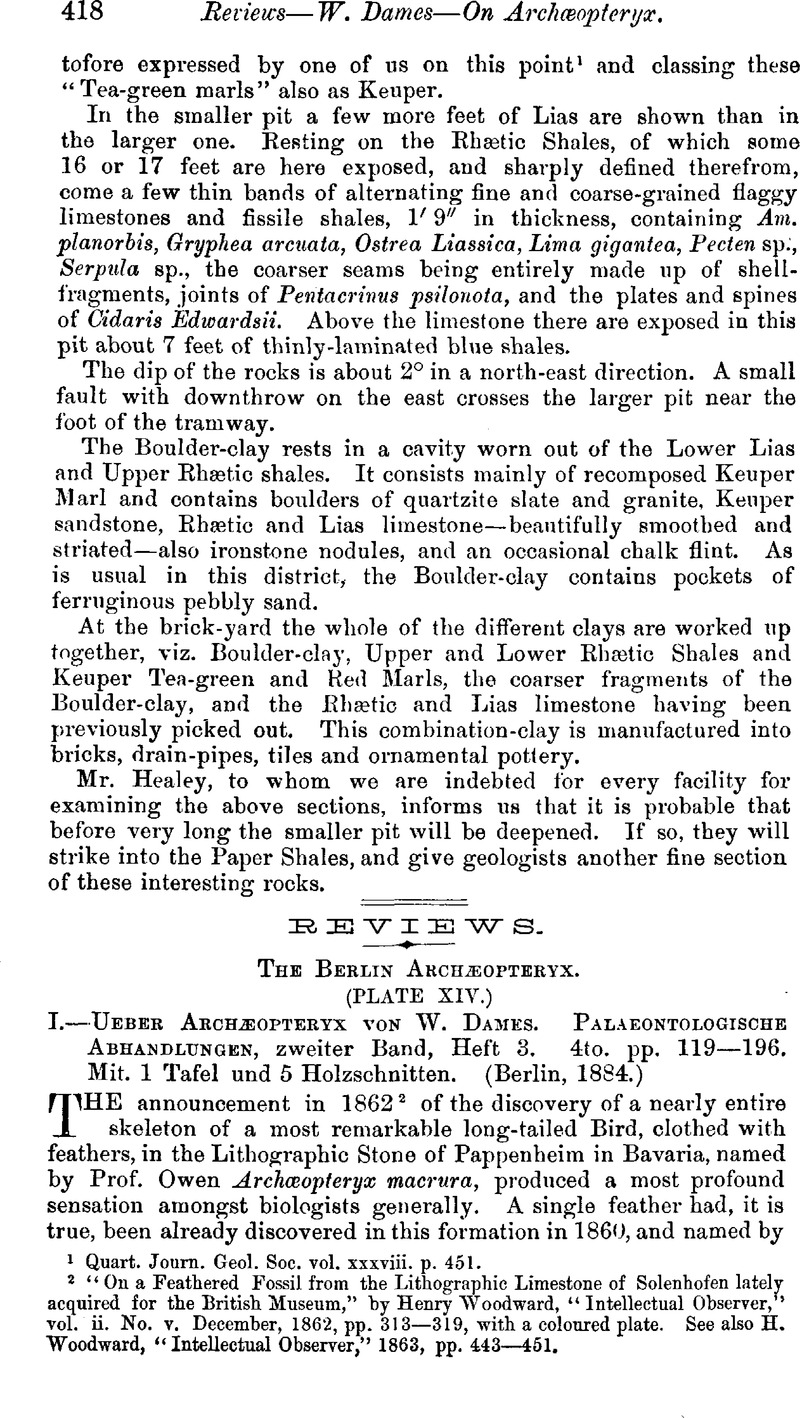Published online by Cambridge University Press: 01 May 2009

page 418 note 1 Quart. Journ. Geol. Soc. vol. xxxviii. p. 451.Google Scholar
page 418 note 2 “On a Feathered Fossil from the Lithographic Limestone of Solenhofen lately acquired for the British Museum,” by Woodward, Henry, “Intellectual Observer,” vol. ii. No. v. 12, 1862, pp. 313–319, with a coloured plate.Google Scholar See also Woodward, H., ”Intellectual Observer,“ 1863, pp. 443–451.Google Scholar
page 419 note 1 Palæontographica, vol. x. p. 53.Google Scholar
page 419 note 2 Sitzungsberichte der Münchner Akad. der Wiss. 1861, p. 146.Google Scholar
page 419 note 3 “On portions of a Cranium and of a Jaw in the Slab containing the Archæopteryx.” by Evans, John, D.C.L., LL.D., F.R.S.. F.G.S., “Natural History Review,” 07, 1865, p. 415.Google Scholar See also article on “Birds with Teeth,” in Popular Science Review, 10. 1875, vol. xiv. No. 57, p. 337, pi. cxxv, by DrWoodward, H., F.R.S., etc.Google Scholar
page 419 note 4 See “Odontornithes, a Monograph on the Extinct Toothed Birds of North America,” by Prof. Marsh, O. C., M.A., F.G.S., 1880. Royal 4to. pp. 202. with 34 plates and 40 woodcuts.Google Scholar
page 419 note 5 “On the Archæopleryx of von Meyer with a Description of the Fossil Remains of a Long-tailed Species from the Lithographic Stone of Solenhofen,” by Prof. Owen, , F.R.S. Read before the Royal Society of London, 20th 11, 1862, published in Phil. Trans, for 1863, pp. 33–48, with four plates.Google Scholar
page 420 note 1 We are indebted to the courtesy of Herr Prof. Dames, W. for the use of the illustration of the head of Archæopteryx from his Memoir.—Edit. Geol. Mag.Google Scholar
page 420 note 2 The complete bony boundary of the orbit is rare in recent birds (the Psittacidæ e.g., see Owen's Anat. Verts, vol. ii. p. 51, fig. 30). In Arehæopteryx it seems to have been continuous around the orbit.Google Scholar
page 421 note 1 The antorbital vacuity in most recent birds is confluent with the anterior nasal foramen (e.g. Alca, Aptornis, Dinornis), not distinctly separated as in Archæopteryx. Didus shows a bar between the vacuities, but in Pezaphaps it is wanting. In Apteryx the anterior nostril is most remote from the ortorbital vacuity. (See Owen's Extinct Wingless Birds, pl. i. fig. 1, pl. lxxxiii. fig. 1, pl. lxxv. fig. l, pl. viii.) Odontopteryx (Q. J. G. S. vol. xxix. pl. xvi. fig. 2nGoogle Scholar) shows an extensive tract of bone between the nostril (n) and the antorbital vacuity (73, fig. 8), the corresponding dividing plate between the antorbital and nasal openings in Archæopteryx is narrow when compared with Odontopteryx, the antorbital vacuity being very large in the former.